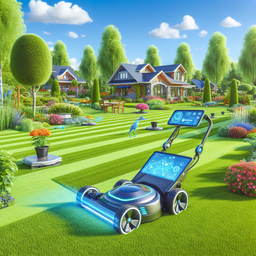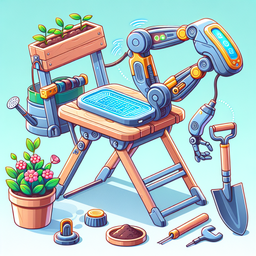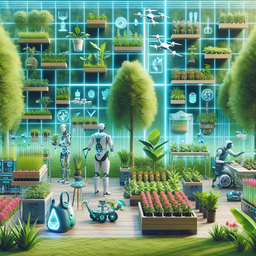Introduction to Indoor Herb Gardening
Indoor herb gardening has gained popularity in recent years as a convenient and rewarding way to enjoy fresh flavors year-round. Whether you live in a small apartment or have limited outdoor space, cultivating herbs indoors allows you to have a readily available supply of aromatic and flavorful herbs, right at your fingertips.
Definition and Benefits
Indoor herb gardening refers to the practice of growing herbs indoors, typically in containers or pots. This method enables individuals to maintain a small herb garden within their living space, regardless of the climate or available outdoor area.
The benefits of indoor herb gardening are numerous. Firstly, it allows for easy access to fresh herbs, eliminating the need to purchase them from supermarkets. This not only saves money in the long run but also ensures that you are using herbs at their peak flavor and nutritional value. Additionally, indoor herb gardening provides the opportunity to customize your herb selection and experiment with a wider variety of herbs that may not be commonly available in stores.
Another advantage of indoor herb gardening is the ability to control and monitor the growing conditions, such as lighting, temperature, and humidity. This can result in healthier and more robust plants, as compared to outdoor gardening where factors like weather and pests can affect plant growth.
Overview of Popular Herbs for Indoor Gardening
When it comes to selecting herbs for your indoor garden, the options are vast. However, certain herbs are particularly well-suited for indoor cultivation due to their adaptability and growth habits.
- Basil
Basil is a versatile herb that thrives indoors. It requires plenty of sunlight and well-drained soil to grow well. Regular harvesting of leaves promotes bushy growth and prevents flowering, which can cause a decline in flavor.
- Mint
Mint is a hardy herb that is known for its vigorous growth. It prefers partial shade and moist soil. However, it is important to note that mint can be invasive, so growing it in a separate container is recommended to prevent it from taking over your herb garden.
- Parsley
Parsley is a biennial herb that is rich in vitamins and minerals. It grows best in a well-lit location with fertile, well-drained soil. Regular watering and the removal of flower stalks help maintain the plant's productivity.
- Chives
Chives are a member of the onion family and are known for their mild onion flavor. They grow well in containers and prefer moist soil and full sunlight. Regular trimming, especially before flowering, stimulates new growth.
- Rosemary
Rosemary is a woody perennial herb that requires bright light and well-drained soil. It is drought-tolerant and does not require frequent watering. Pruning helps maintain a compact and bushy shape.
Setting Up Your Indoor Herb Garden
To ensure the success of your indoor herb garden, it is important to make informed decisions when setting up the garden. This includes choosing the right containers, selecting an ideal location, and providing adequate lighting.
Choosing the Right Containers
When selecting containers for your indoor herb garden, several factors should be considered. Firstly, the size of the container should be appropriate for the herb's root system and overall growth habit. While smaller herbs like chives and parsley can be grown in shallow containers, larger herbs like rosemary and basil require deeper pots.
Secondly, choose containers with drainage holes to prevent waterlogging, which can lead to root rot. It is also advisable to use containers made of breathable materials like terracotta or fabric pots, as they allow for better air circulation and moisture regulation.
Lastly, consider the aesthetics of the containers. Indoor herb gardens can serve as decorative elements in your home, so choose containers that complement your interior design.
Selecting the Ideal Location
The location of your indoor herb garden plays a crucial role in its success. Herbs require a minimum of 6 hours of direct sunlight each day, so choose a location that receives ample natural light. South-facing windows are generally the best option for herb gardens, but if you have limited access to natural light, supplemental grow lights can be used to ensure sufficient light intensity.
Additionally, avoid placing your indoor herb garden near drafty windows, heating vents, or air conditioning units, as these can create temperature fluctuations and dry out the plants.
Providing Adequate Lighting
Proper lighting is essential for the healthy growth of indoor herbs, especially when natural light is limited or inconsistent. While most herbs require at least 6 hours of direct sunlight, not all indoor spaces can provide such conditions. In such cases, supplemental grow lights can be used to provide the necessary light intensity and duration.
When selecting grow lights, it is important to choose ones that emit the appropriate light spectrum for plant growth. Most plants require both red and blue light for optimal growth and development. LED grow lights are a popular choice as they are energy-efficient and can be tailored to emit the desired light spectrum.
Soil and Fertilizer for Indoor Herb Gardening
To ensure the healthy growth of your indoor herb garden, it is important to understand soil composition, select the right soil mix, and choose an appropriate fertilizer.
Understanding Soil Composition
Soil serves as a medium for plant growth, providing essential nutrients, water retention, and root support. Understanding the basic components of soil can help you select the right soil mix for your herbs.
The three primary components of soil are:
- Sand: Provides drainage and aeration
- Silt: Retains moisture and nutrients
- Clay: Provides structure and cation exchange capacity
An ideal soil composition for herb gardening is loamy soil, which is a balanced combination of sand, silt, and clay.
Selecting the Right Soil Mix
When selecting a soil mix for your indoor herb garden, it is best to use a high-quality potting mix specifically formulated for container gardening. Such mixes usually contain a balanced blend of organic matter, perlite or vermiculite for drainage, and nutrients for plant growth.
Avoid using garden soil for indoor gardening, as it can be too heavy and may contain weed seeds or pathogens. Additionally, ensure that the soil mix is sterile and free from contaminants to prevent the introduction of pests or diseases into your indoor garden.
Choosing the Appropriate Fertilizer
Fertilizers provide essential nutrients to plants, promoting healthy growth and productivity. When selecting a fertilizer for your indoor herb garden, consider using organic options that are slow-release and gentle on plants.
Organic fertilizers, such as compost or worm castings, enrich the soil with nutrients and improve its structure over time. Liquid seaweed extract or fish emulsion can also be used as natural fertilizers, providing a readily available source of nutrients to plants.
It is important to follow the manufacturer's instructions when applying fertilizers to prevent overfertilization, which can lead to nutrient toxicity or salt buildup in the soil.
Watering and Maintenance of Indoor Herb Gardens
Proper watering techniques and regular maintenance are essential for the health and productivity of indoor herb gardens. The following tips can help ensure the optimal growth and longevity of your herbs.
Proper Watering Techniques
The most common cause of herb plant decline is improper watering. Overwatering can lead to root rot and fungal diseases, while underwatering can result in wilting and nutrient deficiencies.
When watering your indoor herb garden, observe the following guidelines:
Check the moisture level of the soil before watering. Insert your finger into the soil up to the first knuckle. If the soil feels dry at this depth, it is time to water the herbs.
Water the herbs thoroughly, ensuring that excess water drains out of the bottom of the containers. Avoid leaving the herbs in standing water, as this can promote root rot.
Allow the top inch of soil to dry out before the next watering. This prevents waterlogging and allows the roots to access oxygen.
Preventing Pest Infestations
Indoor herb gardens are not immune to pests. Common pests that can affect indoor herbs include aphids, spider mites, whiteflies, and fungus gnats.
To prevent and manage pest infestations, follow these practices:
Regularly inspect your herbs for signs of pests, such as yellowing leaves, stippling, or webbing.
If pests are detected, isolate the affected herbs to prevent the infestation from spreading.
Use natural pest control methods, such as spraying the herbs with a mixture of water and mild dish soap or using biological control agents like ladybugs or predatory mites.
If necessary, resort to organic insecticides or insecticidal soaps. Always follow the instructions on the packaging and avoid using toxic chemicals that may harm beneficial insects or contaminate your herbs.
Pruning and Harvesting Tips
Pruning and harvesting are important maintenance practices that can help promote bushy growth and ensure a continuous supply of fresh herbs.
Follow these tips when pruning and harvesting your indoor herbs:
Regularly pinch back the tips of your herbs to encourage branching and prevent leggy growth.
Harvest the herbs when they have reached a sufficient size. Cutting the stems just above a leaf node ensures that new growth will emerge.
Avoid removing more than one-third of the plant's foliage at a time, as excessive pruning can weaken the plant.
Prune away any yellowing or diseased leaves to prevent the spread of diseases.
Common Challenges and Solutions in Indoor Herb Gardening
Indoor herb gardening can present several challenges, ranging from nutrient deficiencies to temperature and humidity management. Understanding these challenges and implementing appropriate solutions can help you overcome them.
Dealing with Nutrient Deficiencies
Nutrient deficiencies can manifest as yellowing leaves, stunted growth, or poor flavor in herbs.
To address nutrient deficiencies:
Monitor the health of your herbs and identify any symptoms of nutrient deficiencies.
Adjust the pH of the soil if necessary, as certain nutrients may be more readily available to plants within specific pH ranges.
Apply organic fertilizers or liquid fertilizers to provide the necessary nutrients.
If deficiencies persist, consider getting your soil tested to identify any underlying issues.
Managing Temperature and Humidity
Indoor environments may have temperature and humidity variations that can impact herb growth.
To manage temperature and humidity:
Place a thermometer near your herb garden to monitor the temperature. Most herbs thrive in temperatures between 60°F and 75°F (15°C to 24°C).
If the temperature fluctuates significantly, consider using a small fan or vent to circulate air, or adjust the placement of your herbs.
Maintain adequate humidity levels by placing a tray of water near your herb garden or using a humidifier in dry environments.
Addressing Common Pests and Diseases
Indoor herb gardens are susceptible to pests and diseases, which can hinder plant growth and productivity.
To address common pests and diseases:
Regularly inspect your herbs for signs of pests or diseases.
Practice good sanitation by removing any fallen leaves or debris from the containers.
Avoid overwatering, as damp conditions can create an environment conducive to fungal diseases.
Apply natural pest control methods, such as the use of beneficial insects or organic insecticidal soaps.
Success Stories in Indoor Herb Gardening
Indoor herb gardening has been embraced by individuals with various living situations and motivations. Two specific success stories highlight the versatility and benefits of indoor herb gardening.
Case Study 1: Apartment Gardening with Limited Space
John, a city dweller living in a small apartment, wanted to grow his own herbs, despite having limited outdoor space. He decided to set up a compact indoor herb garden using vertical gardening techniques.
By utilizing wall-mounted planters and hanging containers, John maximized his available space and successfully grew a variety of herbs such as basil, mint, and thyme. He found that his indoor garden not only provided him with a constant supply of fresh herbs but also served as a decorative element in his living room.
Case Study 2: Office Herb Garden for Stress Relief
Sarah worked in a high-stress corporate environment and wanted to create a calming and rejuvenating space in her office. She set up a small herb garden on her desk, consisting of aromatic herbs such as lavender, chamomile, and lemon balm.
Sarah discovered that tending to her herb garden during breaks helped reduce her stress levels and improve her overall well-being. The soothing scents and greenery provided her with a much-needed respite from the hectic work environment.
Conclusion and Implications of Indoor Herb Gardening
Indoor herb gardening offers numerous benefits, ranging from easy access to fresh herbs to the ability to control growing conditions. By following the guidelines and tips discussed in this article, you can set up and maintain a successful indoor herb garden.
The implications of indoor herb gardening extend beyond personal satisfaction and convenience. Cultivating herbs indoors can have a positive impact on health and well-being. The act of nurturing plants and being surrounded by greenery can reduce stress, improve air quality, and promote a sense of calm and tranquility.
In addition, indoor herb gardening contributes to environmental sustainability. By growing herbs at home, you reduce your carbon footprint by minimizing transportation and packaging waste associated with store-bought herbs.
Call to Action: Join the Conversation and Continue Researching
If you are interested in indoor herb gardening or have further questions, it is beneficial to engage in online forums and communities dedicated to indoor gardening. These platforms allow you to connect with fellow gardening enthusiasts, share experiences, and gain valuable insights.
Another way to expand your knowledge is by attending indoor gardening workshops or webinars. These educational events provide opportunities to learn from experts in the field and delve deeper into specific topics related to indoor herb gardening.
Lastly, consider sharing your own indoor herb gardening experiences through social media or personal blogs. By documenting your journey, you can inspire others to embark on their own gardening adventures and foster a community of indoor gardeners.
Indoor herb gardening is a rewarding and fulfilling hobby that brings nature into your home. Start your own indoor herb garden today and experience the joys of growing and harvesting fresh flavors throughout the year.
Topics




